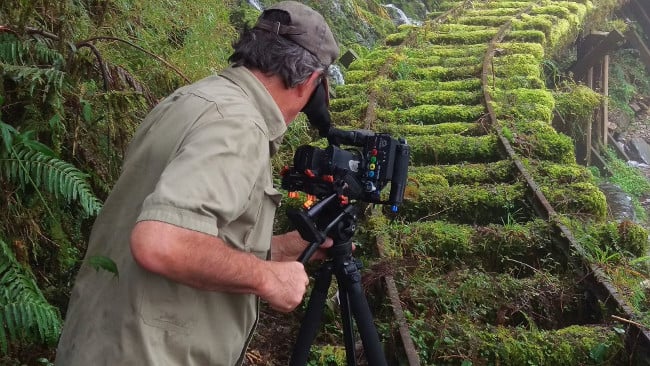
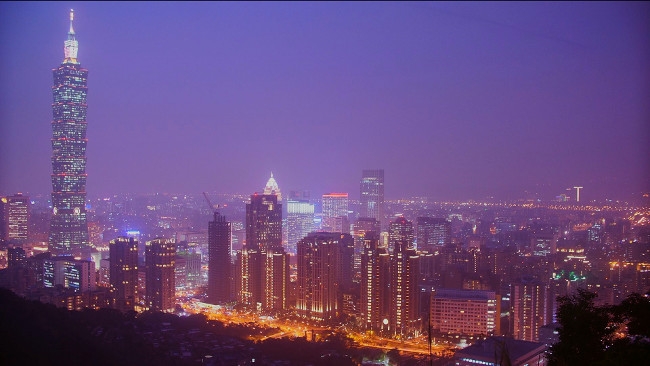 'Taipei 101' dominates the city skyline and is the world's 2nd tallest building
'Taipei 101' dominates the city skyline and is the world's 2nd tallest building
Our intrepid traveller, Craig Marshall, details a recent trip to Taiwan, including his gear of choice for such gigs and workflow insights.
As I write this from my apartment in downtown Taipei, the ClipToolz app is busily batch rendering several hours of ProRes HQ files to TC window MP4s, whilst a colourful and noisy 'Gay Pride' march winds its way down the street below my fourth story window. The photographer in me wants to rush out and capture the spirit of Taiwan's evolving democracy, whilst my more disciplined half sagely councils, "it's not in the brief, so don't steer away from the job at hand."
I've just returned from a 10 day road trip, predominantly shooting mountain railways among the near vertical tea plantations on the 2000m slopes in the interior of old Formosa, now the vibrant Asian Tiger economy which is modern Taiwan. My brief was to shoot video and stills for an international tour wholesaler who sells a series of premium, small group enthusiast tours based around 'railway' themes.
It's not only challenging mountain logging railways this country is famous for. If you edit video on a computer today, chances are you're using a motherboard 'Made in Taiwan'. Apple's penetration into the lucrative smartphone market there seems thwarted, too, as Taiwan's top home grown HTC Android model would appear to outclass the Fruit Company's latest iPhone in every specification.
At the outset, let's say the weather here has been lousy. A heavy smog drifting in across the Taiwan Strait from China to the west means I've probably captured low contrast monochrome pictures, whether I wanted them or not. The popular appellation for this style of documentary filming is 'run and gun', but like many from the 'old school' of television ENG/EFP, it's one of the modern terms like 'dealbreaker' that I've come to loath. Let's call it 'shooting on the run' shall we?
Shooting on the run
The classic Betacam/Digibeta with a 20:1 Fuji or Canon servo zoom was my usual piece of kit for this style of broadcast work, but if you've seen the price of a Fujinon 'Cabrio' S-35 zoom lately, you'll know this large sensor setup is beyond the budget of all but the most well heeled of independent video producers. During my working career in broadcast television back in the '80s and '90s, I spent much of my time shooting TV commercials for 4WDs and heavy transport vehicles in the highlands of Papua New Guinea, so photographing trains winding along steep mountain ridges in the wilds of Taiwan's interior takes me right back into familiar territory. The biggest difference is that, unlike PNG, Taiwan enjoys a 'rule of law', so the chances of a 'hands up' robbery at gun or knifepoint are, thankfully, not even a consideration.
There would be few nations in the Tropics where riding a narrow gauge railway or driving a sealed road across a 3500m mountain pass can be considered a safe, every day activity. However, all is not plain sailing in Taiwan, as the island sits right in the path of regular and devastating tropical storms. In August this year, Typhoon Soudelor dumped 75mm of rain per hour across the interior for more than twenty four hours, with some remote villages recording nearly 2000mm of torrential rain in just two days. This sort of deluge creates widespread havoc with mudslides, landslides and flash flooding a regular spectacle. Unfortunately, one famous narrow gauge railway, which winds steeply up from the coastal plain to 2500m in just 56 km, was cut in half by a major slide back in 2009 and the delicate repairs are yet to be completed.
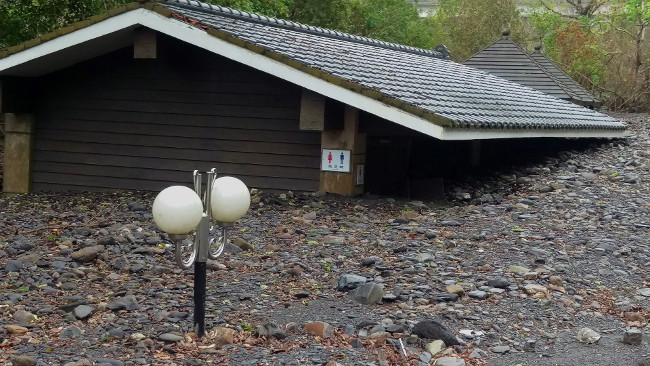 August's Typhoon Soudelor caused massive flood damage at Taipingshan National Park's visitors centre.
August's Typhoon Soudelor caused massive flood damage at Taipingshan National Park's visitors centre.
Camera choice
My camera of choice for this sort of documentary filmmaking today is an older Sony hybrid, a small 'prosumer' camcorder body with an APS-C/S-35 sensor, which records compressed HD internally and uncompressed 4:2:2 video externally (via HDMI), yet also captures RAW, 16 megapixel stills at the flip of a switch. Sony's E-Mount bayonet can adapt to virtually any lens system via dumb adapters or, in my case, through Metabones excellent C/Y to NEX focal reducer. This means I can use my collection of Zeiss 'Contax' stills glass on the S-35 sensor to recover their original 'full frame' field of view. Given the cost of really good wide angle full frame glass today, this is a good thing. With an Atomos Ninja 'Star' ProRes recorder bolted onto my ergonomic rig, I now have a reliable, lightweight and cost-effective hybrid HD system, which I expect will continue to serve me well into the future, even though '4K' seems to be the current industry buzzword.
Anybody who has shot with Contax glass, originating from the West German Carl Zeiss factory back in the 1980s, can quickly become an ardent lens-a-holic and, lately, this premium 'vintage' stills series has enjoyed something of a 'cinema' renaissance, possibly due in no small way to New York DoP Nick Morrison's popular and long running 'Contax Survival Guide' over on the Reduser forum. Their long focus throw, smooth light rolloff and marvelous image rendering have made the vintage Contax series a real hit on modern digital sensors. Although I've shot internationally for several years with Contax primes, this Taiwanese commission was a personal watershed, because it is the first commercial shoot I've completed on three entirely 'new' lenses and, even though two of them are zooms, I prefer to think of them as 'variable primes'.
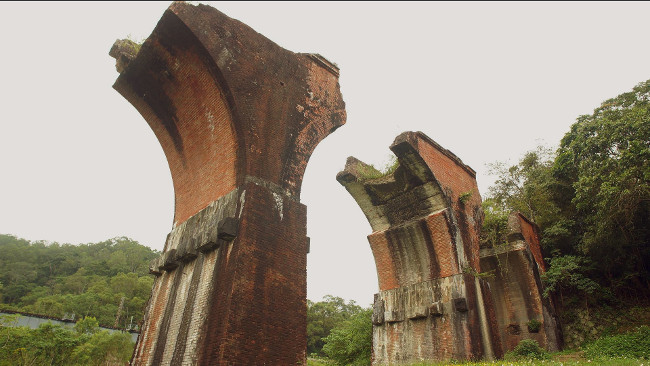 Remains of the old Longtong railway bridge after the 1935 earthquake: Contax 21mm
Remains of the old Longtong railway bridge after the 1935 earthquake: Contax 21mm
Travel considerations
A ten day filming commission to a foreign country where Mandarin is the lingua franca and English is my native tongue required a considerable amount of preparation prior to departure. You need a good local 'fixer' and you need to pack everything you think you'll want under any circumstance, yet keep the total weight manageable and within Airline regulations.
Consequently, my camera equipment weighs in at 25Kg, including a custom designed backpack which takes everything securely packed in, plus a 4kg telescopic alloy 'fluid head' tripod. The latter also has it's own case with shoulder strap, which assists at Airport check-in counters. For this shoot, I wanted to be able to grab the camera, slip it onto the tripod, frame up and focus or swap lenses quickly and efficiently. However, at age sixty now, I can assure you that lugging 25 kilos of camera up steep mountain tracks at 2500 metres above sea level is definitely a younger man's game!
Glass and power
Planning this trip beforehand, l imagined a lot of shooting was going to be at the long end of the focal range and I was correct in that assumption. My choice of glass for this potentially exhausting trip included my new best friend and 'default' lens: the Contax 28-85mm f/3.3, plus a very versatile 80-200mm f/4.0 constant aperture zoom and, finally, for those hand held sequences where deep focus is an essential element, my half kilo Zeiss 21mm f/2.8. I also packed a Mutar 2x Extender for good measure. The legendary Contax 21mm super wide lens enjoys a 93 degree field of view on a full frame sensor, which is pretty much what your eye sees. It can offer full focus, virtually from the front glass to infinity in daylight, yet it still achieves a 90 degree FoV on a S-35 sensor using Metabones' excellent focal reducer, so there's virtually no 'crop factor' to consider. Remember: an additional stop of light is achieved courtesy of the Speed Booster, so the figures quoted above make for excellent low light recordings, coupled with a modest 12-18dB of noise free Gain, should it be required.
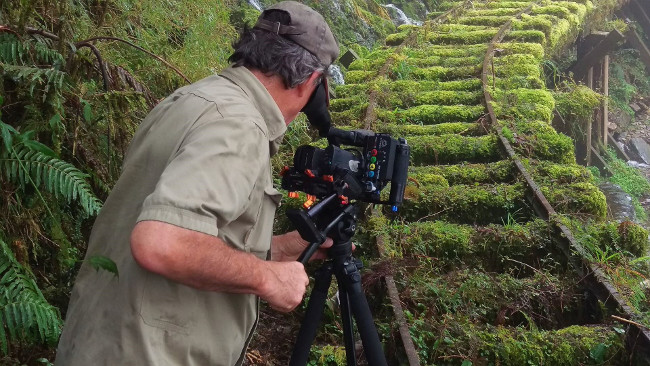 Contax 21mm f/2.8 on the Speed Booster proved ideal when shooting in confined spaces.
Contax 21mm f/2.8 on the Speed Booster proved ideal when shooting in confined spaces.
Batteries are always an issue with video cameras, but fortunately, my rig and all of its various accessories use only two different types of lithium ion batteries and I can charge both types simultaneously from either 110/240v AC mains or 12-24 volts DC. During the course of this two week project, where I shot approximately 30-40 minutes of external ProRes HQ per day, my camera battery lasted two-to-three days before needing a change over and charge up. However, the battery on the Atomos Star recorder need changing at the beginning of each day. Of course, I'm shooting broadcast quality digital HD video here (no 'cinema delusions' for this old boy), so it's 25P ProRes HQ at 200Mbps courtesy of the diminutive Atomos recorder. I like a bit of motion blur (and detest the modern proliferation of high speed shutter videos), so I generally shoot with a '180 degree' shutter and, at 1/50th with the Speed Booster on, there's potentially a lot of light flooding the sensor. Consequently, Neutral Density filters are an essential companion but, rather than bring a full rig and matte box, I opted instead for a simple 'clip on', rotatable 4x4" glass filter holder, which can be quickly adapted to any lens thread. This lightweight device takes one standard thick glass filter plus one thinner acrylic filter, so I can combine a 4x4" Skylight, for example, with a graded ND.
I also packed a new circular 86mm 'wide band' variable ND, which proved exceptionally convenient on this project, especially on the 21mm, because I could set the camera's shutter to 1/50th, iris at say f/5.6, then trim my exposure manually during the shot if required by simply rotating the variable ND with a spare finger. No need for a 'de-clicked' iris! I also employ a large (120mm diameter) metal lens hood on the 21mm wide angel. It has a textured rubber grip around the rim and can be screwed onto the outside of the variable ND filter. Although all Contax glass handles flare exceptionally well, a large diameter lens hood simply makes for better pictures and less work in post production by minimizing the chances of stray rays hitting the front element or any optional filters. I also have a small 'magic arm' permanently attached to the rail & rod system under the camera, which accepts either my battery powered LED video light or one of the barn doors off the matte box. This setup makes for a perfect shooting 'into the sun' scenario, especially at the shorter focal lengths.
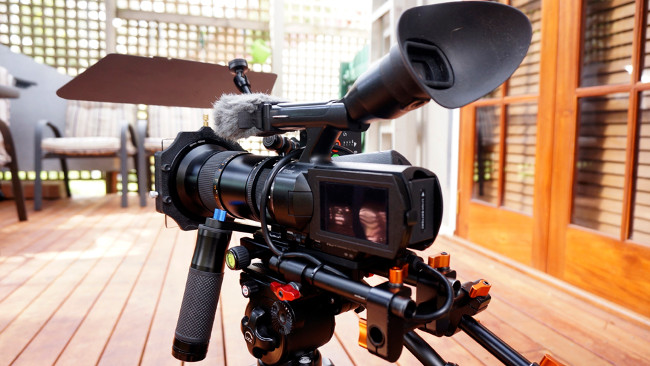 'Swing-out' hand grip on 15mm rails balances a front heavy setup and allows quick focus or iris adjustments.
'Swing-out' hand grip on 15mm rails balances a front heavy setup and allows quick focus or iris adjustments.
Workflow matters
My older Sony camera does not offer RAW video, nor any form of internal 'log' processing, but what it does enjoy is good dynamic range, a dedicated rubber hooded viewfinder, focus peaking, histogram, reliable 100% zebras and an extremely accurate Rec.709 HDMI video output. The Zeiss T* lens coatings are by nature 'low contrast', so the resultant pictures will usually benefit from minor Lift/Gamma/Gain adjustments in Post. To further assist in this area, I regularly shoot through a Schneider Optics 'Digicon' filter, which reduces highlights and lifts shadows by a corresponding amount without softening the image, as can happen with the more popular 'low-con' style filters. I'm now so confident with this lens/camera/recorder setup that I never bother with a field monitor on international shoots.Often, the first time I see my pictures in any detail is when I get home and look at them in my calibrated Lightworks and DaVinci Resolve edit suite.
The Atomos Star ProRes device records HD video and four channels of PCM audio with timecode, but my camera does not generate or pass timecode through HDMI, so I simply re-stripe the ProRes file's timecode track sequentially with ClipToolz by selecting a 'user' start code and manual reel numbers during the 'dub' from the Atomos CFast card reader to an external 2 TB portable USB drive. (I take a lightweight 11" laptop PC with me everywhere and it has two USB ports for quick file offloading) Once the day's shoot is backed up, I next re-configure ClipToolz to batch render a series of 'TC window' dubs to low bitrate compressed MP4s, which can easily be viewed on a smart phone, tablet or any modern television set. I find that viewing these ungraded 'rushes' on a big consumer TV is a great way to asses initial image picture quality, because highlights or issues can easily be identified well before any edit/grading session using only pencil, notepad and the timecode burn visible on the screen.
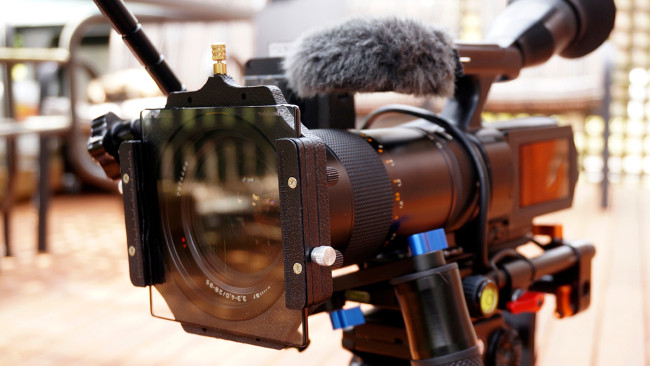 Simple clip-on filter holder rotates and accepts 1 x 4x4” glass plus 1 x 4x4” acrylic filter.
Simple clip-on filter holder rotates and accepts 1 x 4x4” glass plus 1 x 4x4” acrylic filter.
For our Railway themed project, the client asked for a short 'highlights' video based on this trip's locations where, in the company of Tony, my locally hired fixer, we visited most of Taiwan's major transport facilities, including the 300km/hour High Speed Rail and all of the country's popular (and not so popular) narrow gauge branch lines. Even though visitors to Taiwan can enjoy the world's highest and steepest mountain railways, as well as some of the best highland scenery in the sparsely populated interior, this island nation straddling the Tropic of Cancer is blessed with a remarkable first world telecommunications infrastructure. Tony's ability to re-programme his HTC mobile phone with fresh GPS track points, whilst simultaneously chatting to his wife, smoking a cigarette and avoiding a tourist bus overtaking another tourist bus, across double yellow lines, around a blind bend, on a steep mountain road wide enough for only a donkey, soon became somewhat passé after the third such encounter.
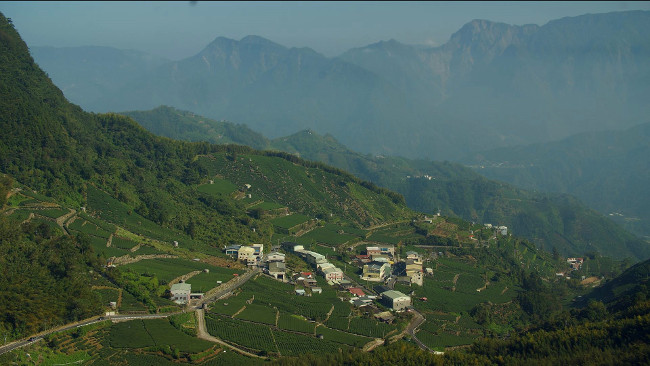 Taiwan is still famous for Formosan Green Tea grown on the slopes above 2000m.
Taiwan is still famous for Formosan Green Tea grown on the slopes above 2000m.
Capturing sound for this particular project was simply a matter of setting the camera's internal pre-amps to manual and letting the more than adequate onboard 5.1 mic array do its stuff in stereo to the Ninja Star's PCM audio tracks. On receipt of my edited, mixed and captioned highlights video, the travel company's marketing people will assess which branch lines and railways might suit their specific niche customers.
Future plans
As a follow-up early next year, we're planning a return visit to complete the project by shooting a short series of scripted promotional videos on each of the chosen travel destinations. This new video series will feature an 'on camera' expert presenter, who will introduce each of the branch line's unique attributes, and a USB drive will be mailed out to each of the travel company's potential clients. This more structured shoot will necessitate my radio lav mics, as well as my Rode NTG3 shotgun and boom, plus a separate PCM recorder and sound person to help achieve a more dedicated and polished sound track.
My 20kg backpack full of delicate lenses and cameras is too large and heavy for carry-on baggage, so my solution is to check it in, fitted inside a cheap suitcase. This looks like anybody else's luggage and protects the pack's straps and pockets from damage or pilfering, but it's a good idea to carry your digital storage files with you in person. Just in case...
Whilst I've been cranking out this piece on my mini laptop, I see ClipToolz has completed its background MP4 timecode 'window' batch renders, so now it's time to find a TV with a USB port and get shot listing!
Tags: Production


Comments